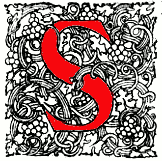
teel cancelled out the one factor which had previously kept mezzotint prints in the minority, namely the fact that the rich velvety tones are dependent on the burr left by the rocker, and the burr on a copper-plate was flattened in the printing press after about 100 impressions. Steel removed this hazard and put mezzotint into competition with line.
Another advantage was that the method of working from dark to light made mezzotint easier to alter and correct; it meant rocking over the faulty area to make it black again. A line-engraving was more laboriously altered by punching out and burnishing the mistake until the area printed white and then reengraving; steel enhanced this difficulty.
Plates were deliberately altered sometimes, to represent different people and a different event. This meant considerable financial saving, but it could not be done easily with a line plate. A mezzotint, for example, engraved in 1837 of Her Majesty the Queen leaving Windsor Castle for the Review showed the Queen on horseback with the Belgian King, Lord Hill and the Duke of Wellington. In 1855 the same plate was republished as 'The Alliance’ The Visit of the Emperor and Empress of France, 1855 (The Belgian King had become Prince Albert, Lord Hill had become the Emperor Napoleon III, and the Duke of Wellington>, who died in 1852, had become the Empress Eugenie and her horse. Also, the ostentatious plumes of the Duke’s militia had modestly subsided.
Mezzotint, being a tonal method, facilitated the imitation of painterly qualities. The fine gradation of tones achieved by scraping and burnishing made it a perfect technique for the translation of portraits, soft drapery and the darker tones of interior settings. [24]
Bibliography
Beck, Hilary. Victorian Engravings. London: Victoria & Albert Museum, 1973.
Last modified 31 July 2018